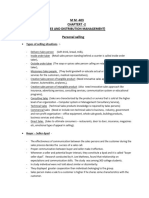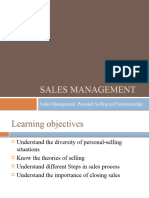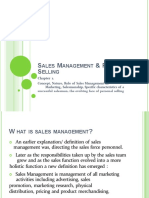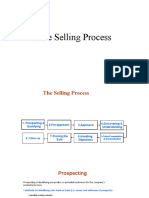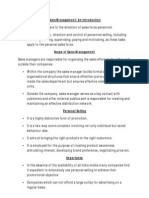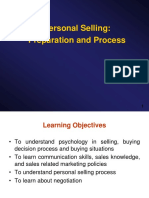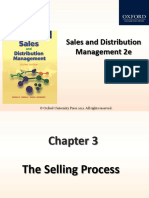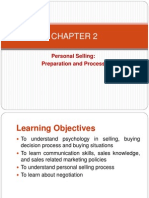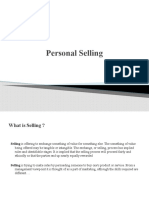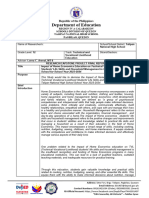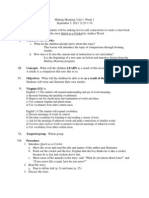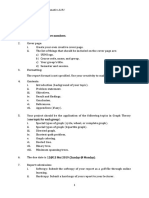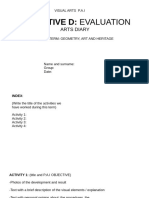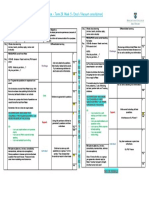INTRODUCTION To Market & Sales
Presented To : Saurabh Mishra
Submitted By :
Vivek Bhattacharya Kunwar Vikram Shreyas Bharadwaj Sandeep Mishra Balram Mishra Gyanesh Shukla
�PERSONAL SELLING
�Definition of Personal Selling
Personal selling
1) two-way flow of communication 2) between a buyer and seller 3) a face-to-face or real time encounter
Why are face to face and two-way important?
�Advantages of Personal Selling
Provides a detailed explanation or demonstration of product Message can be varied to fit the needs of each prospective customer Can be directed to specific qualified prospects
Instant feedback
Personal persuasion can be used A good salesman can get you to buy ice in winter
�When to Use Personal Selling
Product has a high value Product is custom made Product is technically complex
There are few customers
Customers are concentrated
Selling image, not product
�Creating Value Through Salespeople Relationship Selling
building ties to the customer, based on a salespersons attention and commitment to customer needs over time.
�Six stages of Personal Selling
1) Prospecting 2) Pre-approach 3) Approach 4) Presentation 5) Close 6) Follow-Up
�Personal Selling: Prospecting
Prospect- possible customer Qualified Prospect-customer who has desire, means and power to decide Cold Canvassing- seller initiated contact of,potential customers without advance warning.
�Personal Selling: Pre- Approach & Approach 2) Pre-approach-Gathering information (when to call, income level, risk tolerance) 3) Approach-First meeting (Physical impressions highly importantappearance, timeliness, confidence)
�Personal Selling:Presentation
A) Stimulus-Response Format (suggestive selling)
keep suggesting items until the buyer responds, like the McDonalds order taker
B) Formula Selling Format more formal and planned,
like a telemarketer
Canned Selling Presentation Memorized, standardized message conveyed to every prospect. Works when seller is a novice or does not know the buyer well
�Personal Selling: Presentation
Need-Satisfaction FormatLet the customer do the talkingSalesman probes, listens then suggests, like a financial planner
Adaptive Selling- pro-active but selective presentation of offerings, based on pre-approach data
Consultative Selling re-active presentation for problem solution
�Personal Selling: Presentation
Handling Objections
Acknowledge and Convert the Objectionuse the objection as a reason to buy (expensive) Postpone hold off answer because next info will convince buyer (complicated) Agree and Neutralize show the objections insignificance (side effects) Denial refute objection with clear facts
�Personal Selling: Close
Trial Close-Can I put you down for blue or green?
Assumptive Close-ask about delivery or warranty choices.
Urgency Close-Offer valid for today only.
Final Close-Buyer initiated acceptance of the sale.
�Personal Selling: Follow-Up
Address concerns with delivery and installation, so todays customer becomes tomorrows qualified prospect or referral source
�Sales Force Motivation Compensation
Straight Salary Compensation Plan Straight Commission Compensation Plan Combination Compensation Plan
�Sales Force Evaluation
Quantitative Assessments sales quotas
easy but ignores selling environment
Qualitative Assessments behavioral evaluations
attitude attention product knowledge selling skills appearance and professionalism
�Personal Selling
Personal selling involves the two-way flow of communication between a buyer and seller, often in a face-to-face encounter, designed to influence a persons or groups purchase decision.
�Personal Selling Process
The personal selling process consists of six stages: (1) prospecting, (2) preapproach, (3) approach, (4) presentation, (5) close, and (6) follow-up.
�Adaptive Selling
Adaptive selling involves adjusting the presentation to fit the selling situation, such as knowing when to offer solutions and when to ask for more information.
�Consultative Selling
Consultative selling focuses on problem identification, where the salesperson serves as an expert on problem recognition and resolution.
�THEORIES OF SELLING
�THEORIES OF SELLING
Selling
is considered as an art by some and a science by others.
This
has produced two contrasting approaches to the theory of selling.
�Four Theories of Selling
AIDAS Right
set of circumstances Formula
Buying
Behavioral
Equation
AIDAS and Right Set Of Circumstances are seller oriented theories. Buying Formula theory of selling is Buyer oriented. The Behavioral Equation theory emphasizes the buyers decision process but also takes the salespersons influence process into account.
�AIDAS theory of selling
A-Securing attention. I-Gaining Interest. D-Kindling desire.
A-Inducing Action.
S-Building Satisfaction.
�Right Set of Circumstances
Theory can be summarized as Every thing was right. This theory is also known as Situation-response theory. A sales person needs to be well skilled to handle the set of circumstances.
�BYUING FOMULA THEORY OF SELLING
�The name buying formula has been given by the late E.K. Strong.
It is a step-by-step explanation of the buyers needs. Reduced to its simplest form, the mental processes involved in a purchase are
need solution purchase
�After adding the fourth element, it becomes
Need(or problem)
solution
purchase
satisfaction
�After modification in the solution and satisfaction, the buying formula becomes
product and/or service and trade name purchase satisfaction/dissatisfaction
need
�After adding adequacy and pleasant feelings, it becomes
adequacy
feelings
pleasant
product and/or service and trade name purchase satisfaction/dissatisfaction
need
�Behavioral Equation Theory
�Using a stimulus response model and incorporating findings from behavioral research, J.A. Howard explains buying behavior in terms of the purchasing decision process, viewed as phases of the learning process. Four essential elements of the learning process included in the stimulusresponse model are: 1. DRIVES: a) INNATE DRIVES
b) LEARNED DRIVES
�2. CUES:
a) PRODUCT CUES b) INFORMATIONAL CUES
3. RESPONSE 4. REINFORCEMENT
�Howard incorporates these four elements into an equation
B =P * D * k * V
Where
B= response or internal response tendency P= predisposition or the inward response tendency K= incentive potential V= intensity of all the cues
�Carrier In Marketing In Sales & Profession Of Personal Selling
Many managers believe that experience in selling is critical to a good understanding of the business and is an important place to start. The opportunities are numerous, ranging from clerking in retail stores, order taking, telemarketing and many other direct marketing activities, managing clients in endless settings, upto the sophisticated handling of customers for multimillion dollar purchases of raw materials, commodities, and equipment. Sales representation occurs in almost all organizations, including manufacturing, wholesaling, retailing, insurance, real estate, financial services, and many other service businesses.
�THANK YOU






